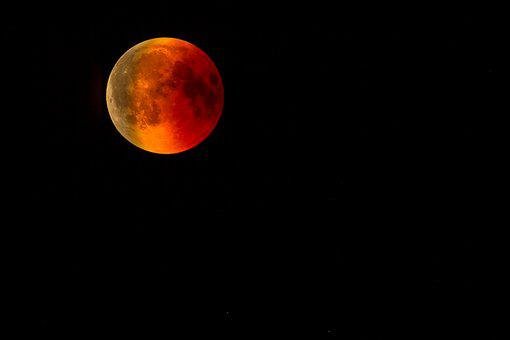Super Flower Blood Moon creates a striking night sky

Image courtesy of Creative Commons
A photograph taken of the Super Flower Blood Moon from a telescope during the May 15-16 eclipse.
June 10, 2022
The sky became a vibrant red as the witching hour came about, Mercury was in retrograde and it was midnight two days after Friday, May 13. But it was not Armageddon, it was the 2022 Super Flower Blood Moon eclipse. On May 15-16, from 10:27 p.m. to 2:27 a.m America saw its longest Super Blood Moon in four years. And after November, America won’t see one for several years.
According to NASA, the moon, although obscured by the Earth’s shadow, reflects sunlight that shines through the Earth’s atmosphere. Because blue and green light gets scattered by Earth’s atmosphere, only red light remains visible.
In Maryland, the blood moon was visible from 10:27 p.m. to 1:55 a.m. with a maximum eclipse at 12:11 a.m. The moon turns red because it reflects the sunset, but for some students, a different light shone, making it difficult to watch the eclipse.
“It’s so hard to see through bright streetlights,” WCHS junior Andee Smith said. “It’s not hard to see [that the moon is] still up there but it’s much less than it would be in an area where there’s no one else for several hundred yards.”
Light pollution has a big impact on the clarity of the lunar eclipse. The large amount of artificial light emitted from streetlights often obscures the moon and makes it difficult for onlookers to watch the eclipse.
“Light pollution had a big impact on the visibility of the moon,” WCHS freshman Aidan Chu-Roxas said. “The clouds were the main reason we couldn’t see it, but the light from a lamppost could [also] block out the moon.”
The cloudy weather also obscured the eclipse and left some students disappointed, as they were unable to watch the eclipse from their homes.
“My dad woke me up around midnight and we drove around for 20 minutes looking for the moon. I had a good time because I got to listen to music as we drove around looking for the moon that was obscured by the clouds,” Chu-Roxas said.
For students who did see the moon, the experience was more noteworthy. As it only happens occasionally, seeing a Super Blood Moon can create lasting memories for students, especially if they are interested in astrology like Smith and know the astrological connotations behind the event.
“Eclipses are significant because they usually bring you towards your future, kind of like spurs along your destiny, and mercury in retrograde is like communication,” Smith said. “Sometimes communications break down, but it is a symbol for you to rethink how you’re communicating with people and reflect. So together it is communication leading to whatever’s going to happen next in your life.”
The eclipse also reminded students of past astronomical events. Five years ago, Maryland experienced a solar eclipse. A solar eclipse is when the moon blocks out the Earth’s view of the sun and leaves the world in somewhat or complete darkness for a few minutes. The lunar eclipse, though less rare than a solar eclipse, allowed many students to reminisce.
“There was a solar eclipse when I was younger. I remember watching that one with my grandparents and we had to get special glasses because you can’t look directly at it,” Smith said. “It wasn’t a full solar eclipse but it was still enough that it got darker and it was really pretty.”
Although the eclipse was obscured for some, it still provided new memories and special moments. If students missed the eclipse on May 15, they should mark their calendars for Nov. 7, 2022, the last long lunar eclipse in the next five years. The eclipse will last five hours and the eclipse will be viable for approximately two hours.
“[The eclipse is] exciting in a way that kind of makes you feel small,” Smith said. “It makes you remember how big the universe really is and how insignificant you are in it, but in a good way. Here’s this major event and all you can do is sit there and watch as it happens.”

